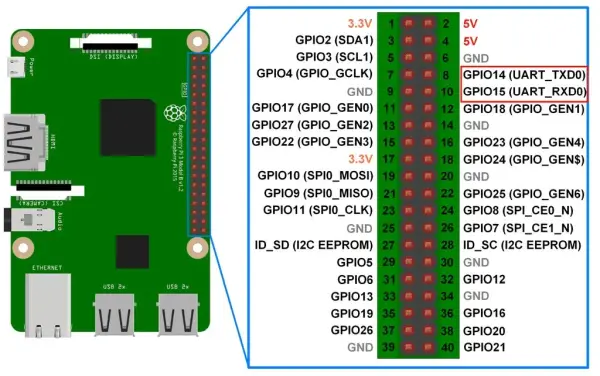Introduction
Universal Asynchronous Receiver/Transmitter or UART is a vital communication protocol used for serial communication in embedded systems and microcontrollers. The Raspberry Pi includes a UART controller that provides serial communication capabilities through its GPIO pins. This allows the Pi to interface with various external serial devices. Python offers a simple yet powerful way to Access Raspberry Pi UART for applications involving data transfer, device control and instrumentation. Being an open-source platform, the Raspberry Pi comes with robust Python libraries that enable seamless UART accessibility from user-defined code. This empower designers to incorporate serial functionality within their projects with minimal effort.
In this article, we will learn how to access the Raspberry Pi 4's UART interface from Python code. We will interface the UART with a variety of popular serial devices and demonstrate communication using simple text and binary protocols. Lastly, we will explore how to optimize performance and scale UART applications. By the end, readers will gain hands-on experience developing serial communication systems on the Raspberry Pi 4 leveraging its UART through a python interface.
Setting Up UART on Raspberry Pi 4
The Raspberry Pi 4 integrates a PL011 UART (Universal Asynchronous Receiver/Transmitter) controller that allows serial communication via GPIO pins 14 (TxD) and 15 (RxD). To enable it:
- Connect the Rx and Tx pins of the external serial device to the Pi's GPIO 14 and 15 pins respectively.
- Ensure the serial device grounds are connected to the Pi's ground pin.
- Install the uart-utils package for utilities:
sudo apt-get install uart-utils ```
- Check if the kernel is accessing UART properly using:
dmesg | grep -i pl011 ```
- Set the desired baud rate, data bits etc using:
echo "9600 8N1" > /dev/ttyS0 ```
- The Pi UART can now be accessed via the /dev/ttyS0 device node from Python code.
This prepares the Raspberry Pi 4 for basic serial communication on its GPIO pins with external UART devices over a voltage-levels translator like a level shifter.
Communicating with Devices over UART in Python
Now that UART is enabled, let us interface it with devices and demonstrate data transfers from Python. These steps elaborate the general process:
- Imports and serial object initialization:
import serial
ser = serial.Serial('/dev/ttyS0', baudrate=9600)
```
- Write to serial – send data from Pi:
ser.write(b'Hello!') ```
- Read from serial – receive data on Pi:
response = ser.read(5) print(response) ```
- Sample Device Interfaces:
- GPS Receiver (NMEA data)
- Temperature/Humidity Sensor (BME280)
- RFID Reader (Text tag data)
- Arduino (ADC readings)
- Parse protocol specific data
- Close port when done
Let us now explore some example applications in depth.
Real-time Data Acquisition System
A common UART application is building an embedded data logger. As an example, we will design a system to log temperature and humidity readings from a BME280 sensor module in real-time:
- Connect BME280's Tx/Rx to Pi GPIO and power.
- Code a Python script with serial initialization and read loop:
import serial, time ser = serial.Serial('/dev/ttyS0', 9600) while True: data = ser.readline().decode() temp, hum = data.split(',') print(temp, hum) time.sleep(1) ``` - Configure BME280 to output comma separated sensor values.
- Run the script and monitor readings in terminal.
- Logs can be stored in file/database for post processing.
This demonstrates a complete Python-based UART application for real-time environmental monitoring leveraging the Pi's serial capabilities.
Industrial Protocol Implementation
UART enables industrial protocols like Modbus RTU which is widely used in building automation, SCADA and industrial control systems.
To integrate a Modbus RTU slave device:
- Define Modbus parser functions to encode/decode requests and responses.
- Set up serial communication as master:
import modbus_tk.defines as cst from modbus_tk import modbus_rtu ``` - Connect, query slave device registers:
master = modbus_rtu.RtuMaster( ser, baudrate=9600, parity='N', stopbits=1, bytesize=8) res = master.execute(1, cst.READ_HOLDING_REGISTERS, 0, 10) ``` - Process 16-bit register values
- Automate control/monitoring application
This exemplifies leveraging the Pi UART to implement industrial protocols opening many IIoT/manufacturing opportunities.
RFID System using UART
Radio-frequency identification or RFID is another domain where UART plays a key role:
- Connect RFID reader module to Pi UART and power.
- Code Python script to continuously read tags:
import serial ser = serial.Serial('/dev/ttyS0', 9600) while True: tag_raw = ser.readline() tag = tag_raw.decode().strip() print('Tag read:', tag) ``` - Integrate with databases/APIs for applications:
- Asset tracking
- Access control
- Inventory management
- Add GUI for user interaction
- Enclose in enclosure along with reader
This exemplifies Python-based RFID systems powered by the Pi's on-board UART controller to leverage cutting-edge auto-ID technologies.
Improving Performance and Scalability
For CPU intensive applications, optimizations can boost UART throughput:
- Use threading/multiprocessing to parallelize data handling from serial interrupts.
- Offload serial I/O to dedicated co-processor via HAT/PHAT add-ons.
- Implement Non-Blocking I/O through select/poll for reactive programming.
- Intermediate buffering and data caching improve input handling efficiency.
- Protocol techniques like message framing structure transmissions for reliability.
At scale, multiple UART ports can be aggregated by:
- Connecting additional UART modules via I2C/SPI expanding serial interface count.
- Routing signals through IP-based protocols over Ethernet/WiFi using gateways.
- Distributing processing load across networked clusters of Edge computers.
Such practices help scale Raspberry Pi UART systems from simple sensors to full-fledged data acquisition networks.
Conclusion
To summarize, this article provided an in-depth overview of how to access and leverage the Raspberry Pi 4's UART serial interface through Python code for building embedded applications. Concrete examples demonstrated Python-based UART hardware interfacing, protocol implementations and high-level system design patterns. With ongoing support through mature serial libraries and frameworks, the Pi empowers creators to develop innovative IIoT, automation and instrumentation solutions harnessing over 25 years of UART's field-proven serial communication dominance.


